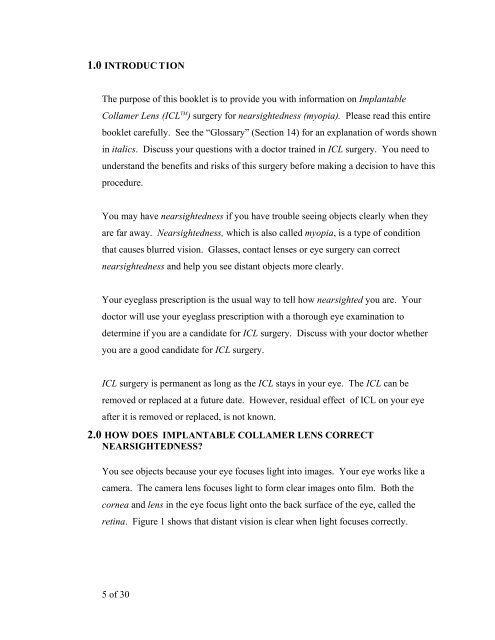ICL Patient Information Booklet
ICL Patient Information Booklet ICL Patient Information Booklet
4 of 30 This page left blank intentionally.
1.0 INTRODUC TION The purpose of this booklet is to provide you with information on Implantable Collamer Lens (ICLTM ) surgery for nearsightedness (myopia). Please read this entire booklet carefully. See the “Glossary” (Section 14) for an explanation of words shown in italics. Discuss your questions with a doctor trained in ICL surgery. You need to understand the benefits and risks of this surgery before making a decision to have this procedure. You may have nearsightedness if you have trouble seeing objects clearly when they are far away. Nearsightedness, which is also called myopia, is a type of condition that causes blurred vision. Glasses, contact lenses or eye surgery can correct nearsightedness and help you see distant objects more clearly. Your eyeglass prescription is the usual way to tell how nearsighted you are. Your doctor will use your eyeglass prescription with a thorough eye examination to determine if you are a candidate for ICL surgery. Discuss with your doctor whether you are a good candidate for ICL surgery. ICL surgery is permanent as long as the ICL stays in your eye. The ICL can be removed or replaced at a future date. However, residual effect of ICL on your eye after it is removed or replaced, is not known. 2.0 HOW DOES IMPLANTABLE COLLAMER LENS CORRECT NEARSIGHTEDNESS? You see objects because your eye focuses light into images. Your eye works like a camera. The camera lens focuses light to form clear images onto film. Both the cornea and lens in the eye focus light onto the back surface of the eye, called the retina. Figure 1 shows that distant vision is clear when light focuses correctly. 5 of 30
- Page 1 and 2: 1 of 30 STAAR Surgical Visian ICL
- Page 3: 3 of 30 TABLE OF CONTENTS 1. Introd
- Page 7 and 8: Wearing glasses and contact lenses
- Page 9 and 10: Description of Study Patient Group:
- Page 11 and 12: 4.0 WHAT ARE THE RISKS OF ICL FOR N
- Page 13 and 14: 6.0 CONTRAIN DICATIONS You should N
- Page 15 and 16: 9.0 ARE YOU A GOOD CANDIDATE FOR IC
- Page 17 and 18: After the iridotomy procedure, your
- Page 19 and 20: 19 of 30 eyeglasses increase over t
- Page 21 and 22: ICL surgery does not eliminate the
- Page 23 and 24: Astigmatic Keratotomy: A type of ey
- Page 25 and 26: Excimer Laser: A type of laser used
- Page 27 and 28: Nearsightedness: A focusing error t
- Page 29 and 30: YAG Laser: (Yttrium Aluminum Garnet
1.0 INTRODUC TION<br />
The purpose of this booklet is to provide you with information on Implantable<br />
Collamer Lens (<strong>ICL</strong>TM ) surgery for nearsightedness (myopia). Please read this entire<br />
booklet carefully. See the “Glossary” (Section 14) for an explanation of words shown<br />
in italics. Discuss your questions with a doctor trained in <strong>ICL</strong> surgery. You need to<br />
understand the benefits and risks of this surgery before making a decision to have this<br />
procedure.<br />
You may have nearsightedness if you have trouble seeing objects clearly when they<br />
are far away. Nearsightedness, which is also called myopia, is a type of condition<br />
that causes blurred vision. Glasses, contact lenses or eye surgery can correct<br />
nearsightedness and help you see distant objects more clearly.<br />
Your eyeglass prescription is the usual way to tell how nearsighted you are. Your<br />
doctor will use your eyeglass prescription with a thorough eye examination to<br />
determine if you are a candidate for <strong>ICL</strong> surgery. Discuss with your doctor whether<br />
you are a good candidate for <strong>ICL</strong> surgery.<br />
<strong>ICL</strong> surgery is permanent as long as the <strong>ICL</strong> stays in your eye. The <strong>ICL</strong> can be<br />
removed or replaced at a future date. However, residual effect of <strong>ICL</strong> on your eye<br />
after it is removed or replaced, is not known.<br />
2.0 HOW DOES IMPLANTABLE COLLAMER LENS CORRECT<br />
NEARSIGHTEDNESS?<br />
You see objects because your eye focuses light into images. Your eye works like a<br />
camera. The camera lens focuses light to form clear images onto film. Both the<br />
cornea and lens in the eye focus light onto the back surface of the eye, called the<br />
retina. Figure 1 shows that distant vision is clear when light focuses correctly.<br />
5 of 30



